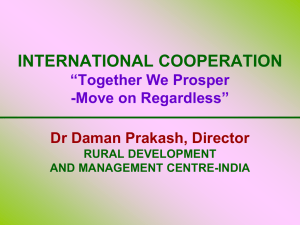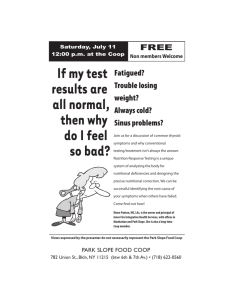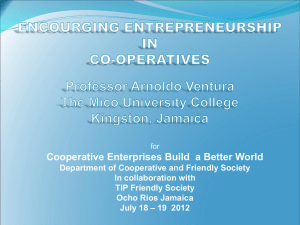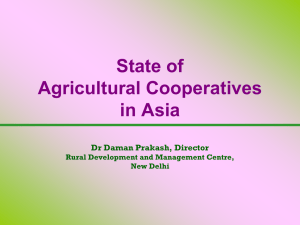Legal Forms of Business Organizations
advertisement
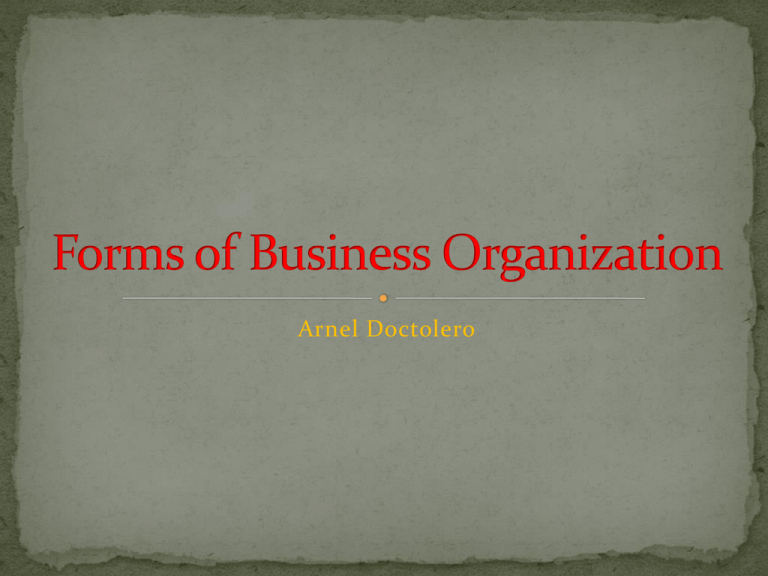
Arnel Doctolero Legal Forms of Business Sole Proprietorships Partnerships Corporations Cooperati ves General Partnership Regular Corporation Limited Partnership Subchapter S Corporation (S-Corporation) Master Limited Partnership Business owned (and usually operated) by one person Simplest form of business ownership Most popular form of business organization – 87.2% of all Most common in: Retailing Service Agriculture Ease of Startup Little legal documentation No co-owners to consult Least expensive to start Pride of Ownership Retention of profits Flexibility No Business Income Tax Unlimited Liability Limited Life – Business ends when owner leaves the business Limited Access to Start-up Capital Limited Access to Credit Limited Management Expertise Difficulty in Hiring Employees Proprietor not considered an employee Two or more owners Least numerous form – 7.7% of all businesses Partnership Agreement Specifies rights and obligations of partners If written, called the Articles of Partnership (Articles of Co-partnership) Greater Access to Capital Greater Access to Credit Retention of Profits More Management Expertise No Business Income Tax Shared Profits Unlimited Liability for “General Partners” Each partner has “Agency” power Limited Life Business ends when any partner withdraws Management Disagreements Frozen Investment General Partner Unlimited Liability Assumes Management Role Limited Partner Liability limited to Investment May not take active managerial role Every partnership must have at least one general partner General Partnership All partners are general partners Limited Partnership One or more limited partners Master Limited Partnership Owned & managed like a corporation Taxed like a partnership Shares may be sold Generally larger than other forms 32.8 % along the entire business company Account for 57.2% of all Business Income Considered a separate legal entity Owners called “Stockholders” or Shareholders” Ownership evidenced by “Stock Certificate” Governed by “Board of Directors” Limited Liability Ease of Ownership Transfer Unlimited Life Greater Access to Capital Specialized Management Expertise More difficult & costly to form Requires a “Corporate Charter” Subject to greater governmental scrutiny Diluted earnings Double taxation SP Corp Income 1,000,000 1,000,000 Expenses 500,000 500,000 EBT 500,000 500,000 (Assume Business Tax Rate = 50%) Business Tax 0 250,000 Net Profit 500,000 250,000 (Assume a 30% Personal Tax Rate) Personal Tax 150,000 75,000 to Owners 350,000 175,000 Legal Permission to Operate as a Corporation Issued by state May not conduct business as a corporation without a charter Company Name & Address Names & addresses of Incorporators Purpose of the Corporation Maximum amount of stock & Classes of Stock to be issued Rights & Privileges of stockholders Length of time the corporation is to exist Common Stock Votes in corporate matters One vote per share owned Preferred Stock No voting rights Dividend claims are paid 1st Dividend Distribution of earnings to the stockholders of a corporation Owners/ Stockholders/ Shareholders Chief Executive Officer (CEO) Board of Directors President Senior Vice President Vice President Finance Vice President Production Vice President Marketing Vice President Human Resources Government-Owned Corporation aka “Public Corporation” Owned & operated by government Post office, PNOC, PAGCOR Quasi-Government Corporation Aka “Quasi-Public Corporation” Privately owned, government controlled monopoly Public utilities, Fannie Mae, Freddie Mac, Sallie Mae Private Corporation Owned by individuals or other companies Not-For-Profit Corporation Organized to provide a social, educational, religious, or other service Habitat for Humanity, Red Cross For-Profit Corporation Closed Corporation Stock owned by relatively few people Stock not sold to general public Open Corporation Stock is bought and sold on security exchanges Can be purchased by any individual S-Corporation (Subchapter-S Corporation) Corporate structure designed for small business Taxed as a partnership if there are 75 or fewer stockholders No non-resident alien stockholders Only one class of stock Limited-Liability Company (LLC) Combines the benefits of a corporation & partnership Not limited to 75 stockholders Hostile takeover Types of mergers Horizontal: Similar products / services Vertical: Different but related firms Conglomerate: Completely different industries Merger Trends Divestiture Leveraged Buyout (LBO) Franchise License to operate an individually owned business as though it were part of a chain of outlets or stores The business itself Franchising Actual granting of a franchise Franchisor Supplies a known & advertised business name Supplies management skills Supplies training & materials Supplies method of doing business Franchisee: Supplies labor & capital Operates the franchised business Agrees to abide by the franchise agreement Franchisor Fast, Selective Distribution Motivated Franchisee Franchisee Opportunity to start a business Business Experience of others Nationally recognized name National promotional campaigns Mainly from Franchisee’s Viewpoint: Franchisor’s contract can dictate every aspect of the business Pay for security Long hours Competition from same company People empowerment is the correct path in solving the problems of poverty and income inequity. It is the process of transferring economic and social power from one center to another and/or the creation of a new center complementary to or in competition with the traditional center (H. Morales). Cooperatives and other labor enterprises are among the major pillars of the people empowerment movement (Sibal, 1991). This movement aspires for a strong pro-people mixed economic society where the state, private and civil society sectors are harnessed in the development efforts of the society. The first stage (1896 to 1941) Pre-formation- germination of coops by revolutionary illustrados Formation- Raiffeisen-type agri-based coops introduced by U.S. missionaries and teachers and western-educated Filipinos State-initiated farmers coops by the American colonial administrators. 1st phase (Japanese occupation)- rapid increase in cooperatives as a result of food shortages 2nd phase- Rehabilitation period after WW II 3rd phase- Resurgence of the state-initiated coops) 4th phase- Introduction and rise of the nonagricultural coops 5th phase- Martial law period and the “politization” of the coop movement. Emerged as a potent political force 1998 party list elections, elected 3 sectoral representatives 2010, 5 Party list representatives in the Philippine Congress Various cooperative laws were codified under RA 6938 in 1990 and amended by RA 9520 in 2009. The coop movement’s involvement in parliamentary struggle avoided “politization” and too much state intervention under the principle of subsidiarity. Operating coops increased by 393 percent from 1983 to 1993, and by 540 percent from 1993 to 2009. The coops’ businesses shifted to higher value added multipurpose coops and its total assets leaped from a measly P1.05 Billion in 1985 to P176 Billion in 2009. The movement’s contribution to the country’s GDP has reached 5.14 percent in 2007. The focus of President PNoy Aquino’s Philippine Development Plan is an “inclusive growth” strategy. It means active participation of the citizenry in the country’s growth and a major beneficiary at the same time (ILO, 2010). It is focused in maximizing job creation in reducing poverty. Hence, the role of the cooperative sector is a vital component in this national endeavor. 1939 1969 1977 1980 1985 1993 2009 Number 570 1,530 1,897 2,941 3,350 25,125 78,611 No. (Confirmed) -- -- -- -- 23,836 Membership (000s) 105 Year Assets (million) Capital (million) 3.4 n.a. 1,142 4,494 555 460 223 30 129 280 1,503 118,400 176,020 129 194 n.a. Sources: 1939-1985- Gray Wine Think Tank, 1993- CDA, 2009- CDA & DOF *1993 (Braid) & 2009 membership covers only confirmed coops 337 3,200 627 -- 5,856* -- 200000 150000 Number No. Confirmed 100000 Members (000) 50000 Assets (Million) 0 1939 1969 1977 1985 1993 2009 The total registered cooperatives increased dramatically by 7.5 times from 1985 to 1993 compared to an increase of only a little over 3 times from 1993 to 2009 (Table 1 & Chart 1). The performance of operating cooperatives increased by 3.9 times from 1985 to 1993, and 5.3 times from 1993 to 2009. This means that more cooperatives are becoming viable after they are registered in 1993-2009 compared to those registered in 1985-1993. The increases in the number of operating cooperatives were bigger in multipurpose cooperatives at 790 percent in 2009, followed by services at 448 percent, producers at 316 percent and marketing at 235 percent. Credit was steady at 157 percent in 2009 (Table 1). Cooperatives now engage in higher value processes compared to lower value processes involved in credit and consumer store operations. Compared to the first and second stages of the coop movement where the government initiated and organized coops for political and anti-insurgency purposes, the third stage of the coop movement avoided these past mistakes with the government supporting the movement with emphasis on the principle of subsidiarity or non-interference on internal coop affairs. Cooperatives during the third stage of the coop movement became more viable and productive. There were lesser coop failures. The operating coops grew rapidly since the total assets of the coop movement leaped from a measly P1.05 Billion in 1985 to P118.4 Billion in 1995, and to P176 Billion in 2009. Category of Coop Micro (up to P3 Million) Small (P3 to P15 Million) Medium (P15 to P100 Million) Large (Over P100 Million) Totals Source: CDA and DOF No. of % to Coops Total No. of Coops 19,961 83.7% Assets P 7.88 Billion % to Total Assets 4.5% 2,594 10.9% P 17.59 Billion 10.0% 1,015 4.4% P 37.83 Billion 21.5% 230 1.0% P112.71 Billion 64.0% 23,836 100.0% P176.02 Billion 100.0% Micro coops dominate the coop sector at 84 percent. If combined with small coops, their numbers reach up to 95 percent. Their assets however total only 14.5 percent compared to the large coops which number only 1 percent but own 64 percent of the total assets. The good thing about this is that micro coops, even with small capitalization, are able to provide more jobs to the poor. Large coops, on the other hand are able to engage in higher value production processes as shown in Tables 3 and 4. The concept of “big brother, small brother” cooperation among cooperatives is necessary. Federation and union work has now become very crucial in furthering the growth of the coop movement. Big coop primaries and federations need to merge or consolidate like the NATCCO-MASS-SPECC consolidation plan in 2012. The big coops, acting as big brothers, need to harness the capabilities of micro and small coops by technology transfers and joint cooperative business ventures like the MICOOP program of the NATCCO. Other new trends in coop business ventures include branding of coop products and services, franchising or networking arrangements, or even outsourcing. Davao (Region XI) highlights the coop movement’s successes in the regions. leads in coop membership at 54.4% of the population of 19 years old and above. with 1.2 million members, it has an average coop membership of 523 per cooperative contributed nine percent to the region’s GDP, following Socsargen (Region XII) at 12% contribution to the regional GDP and Western Visayas (Region VI) at 4.5% contribution to the regional GDP (Tables 5 and 6). Bicol (Region V) and Southern Tagalog (Region IV) are the least performers in coop membership and in regional contribution to GDP. Region IV is a fast growing region in manufacturing and services, hence coops cannot compare with the output of big manufacturing enterprises. Bicol region, being a depressed region in terms of manufacturing, needs more intense coop development to help empower the poor. Source: CDA and DOF * Population of 19 years old and above Member-ship Membership/ Coop (Ave.) % of Coop Membership vs Population Rank – Highest/ (lowest) 1,201,830 523 54.5% 1 IX- Zamboanga 321,917 321 20.6% 2 II- Cagayan 245,640 283 14.64% 3 CAR 124,130 166 14.61% 4 NCR 780,555 297 13.95% 5 V- Bicol 145,440 195 5.55% VII- Western Visayas 238,770 124 6.37% IV- Southern Tagalog 497,085 234 6.80% 5,856,074 246 13.04% Region Top 5 XI- Davao Lowest 3 Philippines (1) Region Percent contribution to regional GDP Rank XII- Socsargen 11.91% 1 VI- Western Visayas 11.49% 2 XI- Davao 9.07% 3 X- Northern Mindanao 8.89% 4 CARAGA 7.45% 5 V- Bicol 1.43% 1 IV- Southern Tagalog 1.55% 2 Cordillera Administrative Region (CAR) 1.84% 3 Philippines 5.14% Top 5 Regions Lowest 3 Regions Source: CDA and DOF 1. Lack of education and training[1] 2. Lack of capital 3. Inadequate volume of business 4. Lack of loyal membership support 5. Vested interest and graft and corruption among coop leaders 6. Weak leadership and mismanagement 7. Lack of government support *From more than 80 researches which assessed the growth and development of coops which included the studies of Emmanuel Velasco, the Cooperative Foundation of the Philippines, Inc. (CFPI) and Leandro Rola (1989). Quality growth Consolidation Differentiation Social relevance National, market presence Poor image- The image of coops is small, inefficient, individual performers with low standard of service, or an image of a jeepney. A large number of cooperatives remain unviable. Only 23,836 or 30 percent of the 78,611 registered coops in 2009 are reporting/operating. 1. There is a need to further strengthen coop education and training through the coop federations, councils and unions, NGO training centers, state colleges and universities, etc. Under RA 9520, all officers (including directors) are required to undergo training conducted by cooperatives, federations and/or other trainers or training institutions duly accredited by CDA. The training modules/curricula prescribed by CDA are: Basic Cooperative Course; Cooperative Management and Governance; Policy Development; Financial Management; Parliamentary Procedure; Leadership and Values ReOrientation; Strategic Planning; and Labor and Other Related Laws. 2. With globalization, small, medium and big coops are exposed to strong competition. Electric coops are threatened by private electric utility distributors for possible buy-ins. Coop rural banks have not grown, some are in difficult situation and have not coped up with the trends in the banking industry. Consumers’ coops (mostly university and institution-based) are caught in a competitive squeeze. 3. Unionization in some medium and big size coops continues. This implies that the coop management practices in some cooperatives are still very reactive and less participative. This has affected some electric coops and large producer coops in Batangas. RA 9520 mandates additional committees of Mediation and Conciliation, and Ethics. 4. Agri-based cooperatives like those in the agrarian reform communities and plantations are not showing improvement in productivity. Some are mismanagement. Strong support services are needed in order to preserve the gains of the coop movement under the Comprehensive Agrarian Reform Law (CARL). 5. The mentality of relying state protectionism, parochialism and close-doorism still prevails among many cooperatives. The present policies of the state have changed and subsidies are being done away with especially during these times of fiscal deficits and global financial crisis. Those that will be affected are the electric, transport, water and irrigation coops. 1. President PNoy Aquino is cooperative friendly. Some key players in the administration are advocates of cooperativism. President PNoy pledged to “continue the revolution that my mother (President Cory) and others started in making entrepreneurship among the poor a strategy for poverty alleviation". Planning Secretary Cayetano Paderanga- “Cooperative development would create jobs and spread wealth”. The coop movement can capitalize on the current boom in the microfinancing business. DSWD Secretary Dinky Soliman is on top of the anti-poverty program of the government. 2. Operating coops increased 4 times from 1985 -1993 and 53 times from 1993-2009. Coops engaged in high value operations increased higher than credit coops. Multi-purpose coops increased by 8 folds, service coops by 4.5 folds, and coop federation by 4 folds. Marketing coops increased by 3 folds and producers coops by 2 folds. 3. The total assets of the coop movement increased by 78 times in 9 years from P1 Billion in 1985 to P118 Billion in 1993, and 117 times in 2009 at P176 Billion. Researches and documentation of the good cooperative practices should be intensified and disseminated to other coops. 4. Coop membership increased by almost 10 times from1985-1993 and 17 times to 5.8 million in 2007. The family beneficiaries are around 19.2 million in 1993. In Davao region, coop members account for more than half (54.5%) of the region’s population of 19 years and older and contributed 9% to the region’s contribution to the regional GDP. Socsargen and Western Visayas contributed to their respective regional GDP at 12% and 11.5% respectively. 6. “Big brother, small brother” cooperation among cooperatives will further the growth of the coop sector. This means more intensive Federation and union work and advocacy that will not compete but will strengthen the operations of the primary coops. Big coop primaries and federations need to merge or consolidate like the NATCCO-MASS-SPECC consolidation plan in 2012. The big coops should harness the capabilities of micro and small coops through technology transfers and joint business ventures like the MICOOP program of the NATCCO. 7. The coop group within the party list bloc in Congress should play its cards well. Although in the minority bloc, the coop legislators are actually representatives of the marginalized sectors of society which comprise the majority of the country’s population. The coop representatives in Congress, aside from their legislative work, should also be active in further uniting and consolidating the coop movement. They should lead the coop movement nationwide together with other coop legislator-advocates: Strengthen all LGU Development Councils and exhort strong coop participation; Work for the creation of Cooperative Development Offices in all LGUs that have not yet created said office and the corresponding appointments of the LGU Cooperative Development Officers ideally coming from the coop sector; Strengthen the Cooperative Development Councils at the national, regional, provincial, municipal and barangay levels; Participate in LGU affairs through involvement in the LGU Pre-Bids and Awards Committees (PBAC), the Local Health and School Boards, to participate in future elections of sectoral representatives for workers, women and other sectors in the LGU councils, and to lobby for the creation of committees on cooperatives in said councils if not yet created. Strengthen the Cooperative Development Councils at the national, regional, provincial, municipal and barangay levels; Participate in LGU affairs through involvement in the LGU Pre-Bids and Awards Committees (PBAC), the Local Health and School Boards, to participate in future elections of sectoral representatives for workers, women and other sectors in the LGU councils, and to lobby for the creation of committees on cooperatives in said councils if not yet created. Remo, Amy, 2011, “NEA, DBP to finance co-ops’ fund requirements”, Philippine Daily Inquirer, July 11, 2011. Rola, Leandro, 1989 “Cooperative Education and Training Issues/Problems and Recommendations”, The State of Cooperative Development in the Philippines, QC: Cooperative Foundation of the Philippines, Inc. Santiaguel, Mannie, 2011, “The Role of Cooperative in Poverty Reduction”, cooperativeunionofcavite.com/.../The%20Role%20of%20Cooperatives%20In%20G lobal%20Poverty... (opned Aug. 201) Scott, William, 1992, The Union Obrera Democratica: The First Filipino Labor Union, QC: New Day Publishers. Sibal, Jorge, 1991, “The Self-managed Enterprises and the Vision of a Mixed Economy”, paper read at the PEDF Seminar-Workshop on Issues in Community Enterprise Management, August 16-18, 1991, Pansol, Laguna sponsored by People’s Enterprise Development Council. Sibal, Jorge, 2001, “A Century of the Philippine Cooperative Movement”, Co-op News from UWCC, University of Wisconsin Center for Cooperatives, August 2001, http://www.wisc.edu/uwcc Wikipedia, 2011, “Fiscal Policy in the Philippines”, http://en.wikipedia.org/wiki/Fiscal_policy_of_the_Philippines (Opened Aug. 2011)
